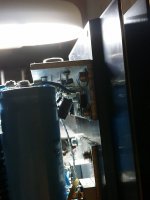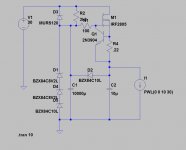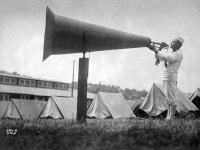Hello. This is my version of CSX1. Power supplies are OK. I hope to finish it during this week.
Those 1000uF/35V ELKOs won't last very long being mounted so close to heatsink.
Thank you guys. The photography is bad. Really capacitor is not so close to heatsink. Transformer is very big, 500VA, (I had it from a failed project). One for channel. Really, all except VFET are from failed projects. I did the first version of Nelson and I had not any problem with noise, but I used laboratory power supply (3 units) and I used KD for K82 and KF for J28. Now I do not know..
Attachments
Why? I think I read the amps stay to 40 Watt in class A in 4 Ohm.
The low damping factor makes bass control quite less... "controlled" in 4ohms... Still, I 'll have to build it and see for myself 🙂
VFET protection
You could of course implement the diyaudio store's DC protection circuit board
Possibly you can find something at Rod Elliot's site.
Nelson Pass uses a regulated power supply for the CSX-amplifiers. It should be fairy easy to sense the current and turn off the power supply/the amplifier in case of excessive currents.
Hi Nelson,
If you don't mind couple questions (reposting from before as they got 'lost'):
- What is the overall gain/sensitivity of this amp?
- Does it need any speaker protection from DC?
- Do Version1 output SITs need to be insulated from the heatsink (since their drains are connected)?
- Can output SITs be of different grade (e.g. KD-33 and KE-33) or the same grade is required?
Thanks,
Vlad
You could of course implement the diyaudio store's DC protection circuit board
Possibly you can find something at Rod Elliot's site.
Nelson Pass uses a regulated power supply for the CSX-amplifiers. It should be fairy easy to sense the current and turn off the power supply/the amplifier in case of excessive currents.
Thank you guys. The photography is bad. Really capacitor is not so close to heatsink. Transformer is very big, 500VA, (I had it from a failed project). One for channel. Really, all except VFET are from failed projects. I did the first version of Nelson and I had not any problem with noise, but I used laboratory power supply (3 units) and I used KD for K82 and KF for J28. Now I do not know..
I'm curious where you are placing your Jensen input trafo, so it is not influenced by the big toroid.....
Yes, it is a big problem. I think there is only one solution: separate the two transformers the maximum and use ferromagnetic shield. I will try both..
This could be a start of the discussion. It limits around 4 A. 0.1 Ohm will double that, more or less.
100R between E and G
Those 1000uF/35V ELKOs won't last very long being mounted so close to heatsink.
At least rotate them by 90 deg.
PCB
What do you guy's think about using the same transformer mounting scheme/board as Teabag used on his F6 boards?
What do you guy's think about using the same transformer mounting scheme/board as Teabag used on his F6 boards?
Good evening
Hi, I have LL1539, is possible to use this transformer?
Good night
try
though - it looks little tricky , judging by http://www.lundahl.se/pdf/1539.pdf
source - best to have negative impedance
without more data , it really demands in vivo confirmation
Jensen transformers GB
Hi all Diyers
Today we have potentially all in GB 50 pieces of Jensen transformer.
Lower price possible ! That is very cool to play team game 😀
! That is very cool to play team game 😀
Next step is finalise this list and buy them in USA and distribute to your sweet home around the world.
********** Let's talk together about in this thread ! **********
http://www.diyaudio.com/forums/grou...-jensen-transformers-sony-vfet-project-6.html
Thanks
Greetings
🙄
Hi all Diyers
Today we have potentially all in GB 50 pieces of Jensen transformer.
Lower price possible
 ! That is very cool to play team game 😀
! That is very cool to play team game 😀Next step is finalise this list and buy them in USA and distribute to your sweet home around the world.
********** Let's talk together about in this thread ! **********
http://www.diyaudio.com/forums/grou...-jensen-transformers-sony-vfet-project-6.html
Thanks
Greetings
🙄

Attachments
Last edited:
- Status
- Not open for further replies.
- Home
- Amplifiers
- Pass Labs
- Article - Sony VFETs part 1


